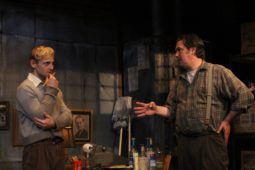Andy Warhol’s Tomato Review by LA Times

‘Andy Warhol’s Tomato’ offers a surprising olive branch in the culture wars
A blue-collar bar owner (Keith Stevenson) has reservations about the unconventional signage proposed by a young Andy Warhol (Derek Chariton) in “Andy Warhol’s Tomato” at Pacific Resident Theatre. (Teak Piegdon-Brainin)
By PHILIP BRANDES
AUG. 16, 2019
 Staunchly working-class Pittsburgh in 1946 was hardly an ideal incubator for creative talent. That incongruity, however, provides an inspired backdrop for the chance encounter between a disillusioned, middle-aged bar owner and a frail, 18-year-old art student destined for greatness in “Andy Warhol’s Tomato,” Vince Melocchi’s quietly touching two-hander making its debut at Pacific Resident Theatre.
Staunchly working-class Pittsburgh in 1946 was hardly an ideal incubator for creative talent. That incongruity, however, provides an inspired backdrop for the chance encounter between a disillusioned, middle-aged bar owner and a frail, 18-year-old art student destined for greatness in “Andy Warhol’s Tomato,” Vince Melocchi’s quietly touching two-hander making its debut at Pacific Resident Theatre.
The drab, close-cropped Andy depicted here by Derek Chariton is a long way from the flamboyant, leather-clad celebrity of the 1960s New York art scene. At this point, young Andy’s ambition to become a commercial artist is hanging by a thread due to failing grades in his first year of college.
With a deadline looming in his last-chance remedial drawing class, a panic attack has left Andy recovering in the basement of a neighborhood bar run by kind-hearted “Bones” Bonino (Keith Stevenson), a self-made businessman who proves surprisingly open-minded despite his gruff no-nonsense demeanor.
Warhol, himself the child of hard-working Eastern European immigrants, shares Bones’ “pull yourself up by your own bootstraps” ethos, but little else. Chariton’s richly-shaded performance is an intriguing mix of Andy’s awkward self-consciousness and unshakable confidence in his own artistic gifts, the detailed career path he’s mapped out for himself.
Andy’s fully-formed marketing savvy comes to the fore when he agrees to paint a street sign for Bones’ bar. Whether he regards Bones as a friend and benefactor or just an interesting specimen is kept deliberately ambiguous for much of the play — beneath the halting “Uhs” that punctuate his diffident banter lurks Warhol’s notorious talent for passive-aggressive manipulation.
Playwright Melocchi has clearly done his homework with respect to historical accuracy. Nevertheless, the play offers more than a biographical sketch thanks to the reciprocal fleeting connection between Chariton’s Warhol and Stevenson’s equally complex performance as Bones, a sympathetic Everyman who harbors an unfulfilled dream of becoming a writer.
Tracing assured emotional beats under Dana Jackson’s finely-tuned direction, Bones’ secret longing is rekindled by Andy’s fearless talent and encouragement. In return, the pragmatic Bones helps Andy overcome his own creative block by urging him to appreciate beauty in the mundane — a simple tomato is a miracle if you look at it the right way. Or package it in a soup can.
Amid the ongoing culture wars between urban-elite and blue-collar sensibilities, Melocchi’s period play slyly reminds us the division can be bridged by our fundamental human need to create. In the process we can become something more than what our circumstances have shaped us to be.
CRITICS CHOICE
‘Andy Warhol’s Tomato’
Where: Pacific Resident Theatre, 703 Venice Blvd., Venice
When: 8 p.m. Thursdays-Saturdays, 3 p.m. Sundays, through Sept. 22
Tickets: $25-$34
Info: (310) 822-8392 or pacificresidenttheatre.com
Running time: 1 hour, 20 minutes
